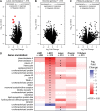Intraspecific variation in immune gene expression and heritable symbiont density
- PMID: 33901257
- PMCID: PMC8102006
- DOI: 10.1371/journal.ppat.1009552
Intraspecific variation in immune gene expression and heritable symbiont density
Abstract
Host genetic variation plays an important role in the structure and function of heritable microbial communities. Recent studies have shown that insects use immune mechanisms to regulate heritable symbionts. Here we test the hypothesis that variation in symbiont density among hosts is linked to intraspecific differences in the immune response to harboring symbionts. We show that pea aphids (Acyrthosiphon pisum) harboring the bacterial endosymbiont Regiella insecticola (but not all other species of symbionts) downregulate expression of key immune genes. We then functionally link immune expression with symbiont density using RNAi. The pea aphid species complex is comprised of multiple reproductively-isolated host plant-adapted populations. These 'biotypes' have distinct patterns of symbiont infections: for example, aphids from the Trifolium biotype are strongly associated with Regiella. Using RNAseq, we compare patterns of gene expression in response to Regiella in aphid genotypes from multiple biotypes, and we show that Trifolium aphids experience no downregulation of immune gene expression while hosting Regiella and harbor symbionts at lower densities. Using F1 hybrids between two biotypes, we find that symbiont density and immune gene expression are both intermediate in hybrids. We propose that in this system, Regiella symbionts are suppressing aphid immune mechanisms to increase their density, but that some hosts have adapted to prevent immune suppression in order to control symbiont numbers. This work therefore suggests that antagonistic coevolution can play a role in host-microbe interactions even when symbionts are transmitted vertically and provide a clear benefit to their hosts. The specific immune mechanisms that we find are downregulated in the presence of Regiella have been previously shown to combat pathogens in aphids, and thus this work also highlights the immune system's complex dual role in interacting with both beneficial and harmful microbes.
Conflict of interest statement
The authors have declared that no competing interests exist.
Figures




Similar articles
-
The nutritional dimension of facultative bacterial symbiosis in aphids: Current status and methodological considerations for future research.Curr Res Insect Sci. 2023 Dec 20;5:100070. doi: 10.1016/j.cris.2023.100070. eCollection 2024. Curr Res Insect Sci. 2023. PMID: 38222793 Free PMC article. Review.
-
Intraspecific variation in symbiont density in an insect-microbe symbiosis.Mol Ecol. 2021 Mar;30(6):1559-1569. doi: 10.1111/mec.15821. Epub 2021 Feb 11. Mol Ecol. 2021. PMID: 33512733
-
Variation in density, immune gene suppression, and coinfection outcomes among strains of the aphid endosymbiont Regiella insecticola.Evolution. 2023 Jun 29;77(7):1704-1711. doi: 10.1093/evolut/qpad071. Evolution. 2023. PMID: 37094805
-
More Is Not Always Better: Coinfections with Defensive Symbionts Generate Highly Variable Outcomes.Appl Environ Microbiol. 2020 Feb 18;86(5):e02537-19. doi: 10.1128/AEM.02537-19. Print 2020 Feb 18. Appl Environ Microbiol. 2020. PMID: 31862723 Free PMC article.
-
The evolutionary ecology of symbiont-conferred resistance to parasitoids in aphids.Insect Sci. 2014 Jun;21(3):251-64. doi: 10.1111/1744-7917.12067. Epub 2014 Feb 14. Insect Sci. 2014. PMID: 24167113 Review.
Cited by
-
Colonization Resistance of Symbionts in Their Insect Hosts.Insects. 2023 Jun 30;14(7):594. doi: 10.3390/insects14070594. Insects. 2023. PMID: 37504600 Free PMC article. Review.
-
The nutritional dimension of facultative bacterial symbiosis in aphids: Current status and methodological considerations for future research.Curr Res Insect Sci. 2023 Dec 20;5:100070. doi: 10.1016/j.cris.2023.100070. eCollection 2024. Curr Res Insect Sci. 2023. PMID: 38222793 Free PMC article. Review.
-
Mechanisms and Evolution of Heritable Microbial Density in Insect Hosts.mSystems. 2021 Aug 31;6(4):101128msystems0072821. doi: 10.1128/mSystems.00728-21. Epub 2021 Aug 31. mSystems. 2021. PMID: 34463570 Free PMC article.
-
Frequent Drivers, Occasional Passengers: Signals of Symbiont-Driven Seasonal Adaptation and Hitchhiking in the Pea Aphid, Acyrthosiphon pisum.Insects. 2021 Sep 8;12(9):805. doi: 10.3390/insects12090805. Insects. 2021. PMID: 34564245 Free PMC article.
-
Individuality in the Immune Repertoire and Induced Response of the Sponge Halichondria panicea.Front Immunol. 2021 Jun 16;12:689051. doi: 10.3389/fimmu.2021.689051. eCollection 2021. Front Immunol. 2021. PMID: 34220847 Free PMC article.
References
Publication types
MeSH terms
LinkOut - more resources
Full Text Sources
Other Literature Sources

